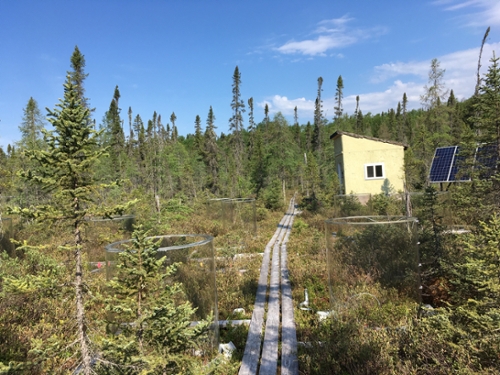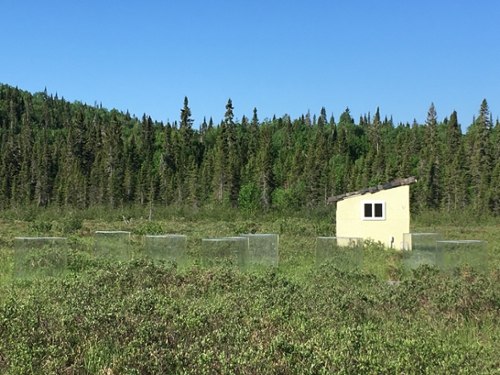BRACE for it...
The BRACE Project is a collaboration with Dr. Brian Branfireun (Western), the Ontario Ministry of Natural Resources and Forestry-Ontario Forest Research Institute (OMNRF-OFRI) and the Canadian Forest Service Great Lakes Centre (CFS-GLC).
This large-scale field experimental system includes 16 experimental and two reference plots, a CO2 delivery system, a ground-heating system, and an off-grid power system at two peatland sites that differ in vegetation, nutrient status and hydrology (N=36 plots). In my lab we provide important baseline, monitoring and treatment response data through ongoing vegetation and soil fauna biodiversity surveys, and measures of decomposition dynamics.

Open-topped chambers (OTCs) at the two BRACE peatland sites. Above: the Sphagnum-dominated, nutrient poor fen site. Below: the Carex-dominated, intermediate nutrient fen site.

Publications from the BRACE Experimental Research Project
- Barreto, C., Buchkowski, R.W., and Lindo, Z. 2024. Restructuring of soil food webs reduces carbon storage potential in boreal peatlands. Soil Biology and Biochemistry 193: 109413. https://doi.org/10.1016/j.soilbio.2024.109413.
- Barreto, C.*, Branfireun, B.A., McLaughlin, J., and Lindo, Z. Responses of oribatid mites to warming in boreal peatlands depend on fen type. Pedobiologia – Journal of Soil Ecology (Virtual Special Issue on Response of Soil Biodiversity to Global Change) 89: 150772 https://doi.org/10.1016/j.pedobi.2021.150772 *graduate student
- Barreto, C.*, and Lindo, Z. Checklist of oribatid mites (Acari: Oribatida) from contrasting two boreal fens: an update on oribatid mites of Canadian peatlands. Systematic and Applied Acarology 26: 866–884. https://doi.org/10.11158/saa.26.5.4 *graduate student
- Tian, J., Branfireun, B.A., and Lindo, Z. Climate change alters peatland carbon cycling through plant biomass allocation. Plant and Soil 455: 53–64. DOI: 10.1007/s11104-020-04664-4
- Lyons, C.L.*, Branfireun, B.A., McLaughlin, J., and Lindo, Z. Climate warming increases plant community heterogeneity in boreal peatlands. Journal of Vegetation Science 31: 908–919. DOI: 10.1111/jvs.12912 *graduate student
- Lyons, C.L.*, and Lindo, Z. Above- and belowground community linkages in boreal peatlands. Plant Ecology 221: 615–632. DOI: 10.1007/s11258-020-01037-w *graduate student
- Asemaninejad, A.*, Thorn, R.G., Branfireun, B.A., and Lindo, Z. Vertical stratification of peatland microbial communities follows a gradient of functional types across hummock-hollow microtopographies. Écoscience 26: 249–258. DOI: 10.1080/11956860.2019.1595932. *graduate student
- Asemaninejad, A.*, Thorn, R.G., Branfireun, B.A., and Lindo, Z. 2018. Climate change favours specific fungal communities in Boreal peatlands. Soil Biology and Biochemistry 120: 28– DOI: 10.1016/j.soilbio.2018.01.029 *graduate student
- Barreto, C.R.A.*, and Lindo, Z. 2018. Drivers of decomposition and detrital invertebrate communities differ across a hummock-hollow microtopology in boreal peatlands. Écoscience 25: 39– DOI: 10.1080/11956860.2017.1412282. *graduate student
- Palozzi, J.E.*, and Lindo, Z. Pure and mixed litters of Sphagnum and Carex exhibit a home-field advantage in Boreal peatlands. Soil Biology and Biochemistry 117: 161–168. DOI: 10.1016/j.soilbio.2017.08.026 *graduate student
- Palozzi, J.E.*, and Lindo, Z. 2017. Boreal peat properties link to plant functional traits of ecosystem engineers. Plant and Soil 418: 277– DOI: 10.1007/s11104-017-3291-0 *graduate student
- Dieleman, C.M.*, Branfireun, B.A., and Lindo, Z. 2017. Northern peatland carbon dynamics driven by plant growth form — the role of graminoids. Plant and Soil 415: 25– DOI:10.1007/s11104-016-3099-3 *graduate student
- Asemaninejad, A.* Thorn, R.G., and Lindo, Z. Vertical distribution of fungi in hollows and hummocks of boreal peatlands. Fungal Ecology 27: 59–68. DOI: 10.1016/j.funeco.2017.02.002 *graduate student
- Asemaninejad, A.* Thorn, R.G., and Lindo, Z. Experimental climate change modifies degradative succession in boreal peatland fungal communities. Molecular Ecology. 73: 521–531. DOI: 10.1007/s00248-016-0875-9 *graduate student
- Del Giudice, R.* and Lindo, Z. Short-term leaching dynamics of three peatland plant species reveals how shifts in plant communities may affect decomposition processes. Geoderma 285: 110–116.DOI:10.1016/j.geoderma.2016.09.028. *graduate student
- Climate change effects on peatland decomposition and porewater dissolved organic carbon biogeochemistry. Biogeochemistry 128: 385–396. DOI: 10.1007/s10533-016-0214-8. *graduate student
- Dieleman, C.M.*, Branfireun, B.A., McLaughlin, J.W., and Lindo, Z. Enhanced carbon release from a northern poor fen under future climate conditions: Role of phenolic compounds. Plant and Soil 400: 81–91. DOI: 10.1007/s11104-015-2713-0. *graduate student
- Lindo, Z. Warming favours small-bodied organisms through enhanced reproduction and compositional shifts in belowground systems. Soil Biology and Biochemistry 91: 271–278. DOI: 10.1016/j.soilbio.2015.09.003.
- Dieleman, C.M.*, Branfireun, B.A., McLaughlin, J.W., and Lindo, Z. Climate change drives a shift in peatland ecosystem plant communities: Implications for ecosystem function and stability. Global Change Biology 21: 388–395. *graduate student


